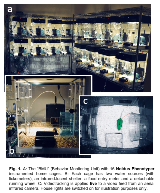An Objective Description of PTZ Kindling in a Standardized Instrumented Home Cage Environment
Abstract number :
1.065
Submission category :
1. Basic Mechanisms / 1E. Models
Year :
2018
Submission ID :
501216
Source :
www.aesnet.org
Presentation date :
12/1/2018 6:00:00 PM
Published date :
Nov 5, 2018, 18:00 PM
Authors :
Miranda Jankovic, Baylor College of Medicine and Vaishnav Krishnan, Baylor College of Medicine
Rationale: The GABA antagonist pentylenetetrazole (PTZ) is a popular chemoconvulsant that is utilized to screen anticonvulsant agents, phenotype seizure propensity in mutant mice and describe the neuroplasticity associated with single or repeated seizure experiences. Intraperitoneal injections of PTZ result in immobility, myoclonic jerks and generalized convulsions. Traditionally, “seizure severity” is assayed during short (20-30 min) post-injection observation periods that report “latency to convulsion”, scores of convulsive severity (e.g., Racine scales) or rarely, electroencephalographic measures. In this study, we applied home cage monitoring to objectively and quantitatively describe the acute ictal, postictal and “interictal” behavioral changes induced by repeated PTZ injections. Methods: Sixteen ~45d old c57bl6J mice (male, bred within our animal facility) were individually housed in instrumented home cages fitted with a ceiling-mounted infrared camera enabling live video tracking with a sampling rate of 15 Hz. These cages were also furnished with an infrared lucent shelter, two lickometered water sources (0.8% sucrose vs drinking water) and a “beam-break” feeding meter (lights OFF between 1700-0500). After 48h of undisturbed baseline recordings, 10 mice received ten daily 30 mg/kg intraperitoneal injections of PTZ at ~1200, while 6 others received saline alone. We closely examined behavior during the immediate post-injection period (~1200-1500) as well as daily ~18h recordings of the “interictal” state (1600-1100). Results: Saline injections produced early hyperactivity that lasted for approximately 10-20 minutes. In contrast, PTZ injections produced “early” (~ th PTZ injection, but displayed similar responses to PTZ on earlier injections. Over the 10-day protocol, the PTZ group displayed prominent reductions in locomotor activity and feeding behavior during “interictal” periods (p<0.01) well before the onset of convulsive seizures. Twenty-four hours following the last injection, PTZ treated mice displayed an unexpected anxiolytic response to a bright light stimulus (“light spot”), but were no different in measures of voluntary wheel running. Conclusions: These results demonstrate the utility of automated home cage monitoring in studying the ictal and interictal aspects of PTZ-induced seizures and chemical kindling. Our approach reveals that injections of PTZ induce a rich and complex pattern of behavioral changes that extend well beyond the acute “ictal” period and which can be quantitatively assayed in an automated fashion with fine temporal resolution using home cage monitoring techniques. Currently, we are extending this approach to improve our ability to determine “seizure thresholds” in mouse models of inherited epilepsies. Funding: Funding: Baylor College of Medicine Seed Grant (VK), American Academy of Neurology Clinical Research Training Fellowship in Epilepsy (VK)

.tmb-.png?Culture=en&sfvrsn=9f53f668_0)